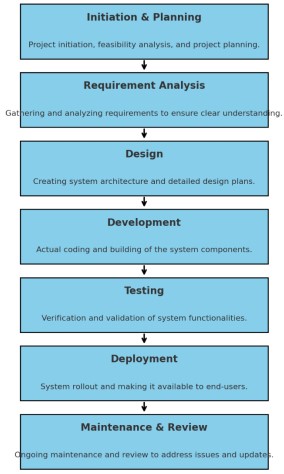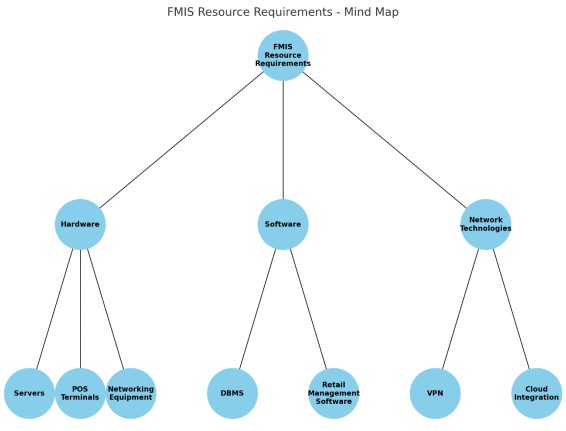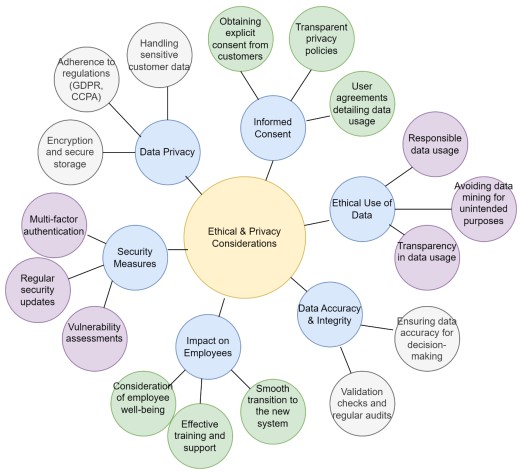Design and Development of a Scalable Retail Information System for FreshMart ISY3021
- Subject Code :
ISY3021
Introduction
The project is to come up with and design a fresh Information System for FreshMart Retail (FMIS) which is a national grocer that is being struggling with operational issues because of an outmoded Retail Management Information System (RMIS). Existing RMISs, receive critiques on real time stock updates, data consensus, stability, and expansion without compromising productivity and customer satisfaction and security. To tackle such challenges, the proposed FMIS will be aimed at improving matters of inventory, integration and coordinating the input data from various department, make the front end user interface more friendly. Further, the system will be extendable for growth opportunities of FreshMart and contain sophisticated analysis to make better decisions.
Scope of the Project
The project to be undertaken for FreshMart Retail is titled FreshMart Information System (FMIS) project and is vast in the way that it not only aims at designing a structure as well as rolling out an efficient and large-scale system that can deal with the issues FreshMart Retail currently comes across.
Main Features
Real-Time Inventory Management: Just for this we need to introduce a system, that allows tracking and updating of stocks in real time across all the store locations to minimize the instances of stockouts or overstock (Badgujar, 2020).
Data Integration: There should also be efforts to have data integration across the various departments, at least including, the sales and inventory, financials, and customer relationship management (CRM) to help in reducing isolation of some form of data from the entire outlook of the operations.
User-Friendly Interface: Design an easy to use and contemporary user interface for the system that means less time training the staff in the stores as well as the managers.
Scalability: Make the system expand in harmony with FreshMart thus ensuring that the rate of responsiveness does not decrease when there are many stores.
Cybersecurity: Ensure that the security of the customers information as well as the financial information is well enhanced and that they meet the legal and regulatory standards.
Advanced Analytics and Reporting: Also, incorporate capabilities for recording and analysis of detailed results to enable the managers to make the right decisions based on trends of the sales, behavior of the customers, and the stock.
Limitations and Constraints
Budget and Resources: Due to a set of constraints the project has to deal with fixed budget and hence not all the new age features or innovative technologies could be incorporated into the project.
Implementation Timeline: The system should be implemented and deployed within certain time constraints which means that we need to prioritize on features.
Legacy Integration: While using FMIS some of the existing system or data source may need to be incorporated and this may cause compatibility issues.
Staff Training: Sufficient training must be given but due to short time it is not much possible to give detailed training to all the employees.
System Development Life Cycle (SDLC)
Chosen Methodology
The Agile Scrum methodology (Hema et al., 2020), proves to be the most suitable for the development of the FreshMart Information System (FMIS). It is for these reasons that Scrum is appropriate for this project; it is an Agile process that is suited for a dynamic project environment such as FreshMart Retail because it is an iterative process that places a lot of value on the customers.
Justification
Iterative Development: Integrated from an agile perspective, the Scrumban approach makes it possible to introduce the iterative development approach, whereby the project team can implement and achieve functional components of the FMIS in limited time frames known as sprints. This is beneficial as it means that there is constant feedback and the system can be changed to better suit FreshMarts day-to-day operation (Shastri et al., 2021).
Customer Collaboration: Organization-members communication is frequent in scrum ensuring the management of FreshMart is fully engaged in the development phase. It is easier to solve any problem that may be encountered for this collaboration reduces the possibility of having a system that does not suit the business requirements.
Flexibility and Adaptability: The environment of FreshMarts retailing calls for a method that can be easily adjusted to future conditions. The strength of Scrums is its ability to organize the development in a relative freeform manner and still guarantee that the most important features feed into the first version.
Risk Mitigation: It thus can be argued that due to its incremental system delivery, Scrum lowers the risk of big scale technological system implementations. The daily testing and integration in each sprint means that if there exists a problem in the system, it can be detected and fixed while the development is still on.
In general, Agile Scrum is the methodology that can be regarded as efficient, adaptable, and customer-oriented to develop the FMIS for FreshMart Retail (Shastri et al., 2021).
Proposed SDLC Phases and Details of the Activities Planned for Each Phase
The Agile Scrum methodology organizes the development process into iterative sprints, each encompassing the following SDLC phases (Olorunshola & Ogwueleka, 2022):
1.Initiation and Planning:
Identify the goals of the project, its create the scope and outline the objectives of the project. Create the actual plan with which you want to approach this project; define the objectives and mark down the most important points to be achieved. Transform the hierarchy and introduce the Scrum team: roles and responsibilities. Collect and identify the key, important and high-priority requirements and generate an initial list of items in the product backlog.
2.Requirement Analysis:
Identify specific requirements from each member of FreshMart through a detailed analysis. That is exactly why the organization needs to prioritize and groom the product backlog items, to make sure that they are fit for the specified business objectives. This shall call for the formulation of user stories and acceptance criteria in order to define the functionality.
3.Design:
Architecture the system with an aim of scaling it, securing it and make sure it can communicate with the other systems that are currently in place. Build models with a focus on prototyping and technology structure, such as wireframes, user interfaces and database schemas. Estimate the software, hardware and network application that will be needed from the technical point of view.
4.Development:
Roll it out in stages preferably the agile software development sprints. Coding is the construction of the identified features in the product backlog while unit testing involves creating tests for coded features as well as integration testing of the features. These recommendations should be periodically reviewed and synchronized according to the experience of evaluation in the course of sprint reviews.
5.Testing:
Functional testing, Integration testing, and Security testing must be run throughout each of the sprints. Perform the user acceptance testing (UAT) in order to know that all features implemented in the system are appropriate in satisfying FreshMart needs and requirements.
6.Deployment:
The system should be implemented gradually and the initial implementation should be in selected stations. To perform and support this system, there is a need to train end-users and IT staff. Some of the activities are; Ensure that your system is functioning outstanding and if there is a problem overcome it during the deployment process.
7.Maintenance and Review:
They should continue to give consistent support to the application by fixing the bugs, upgrading and improving the program. This should be done in order to evaluate the performance of the system and to find out if anything can still be done to enhance it. This involves updating on the product backlog to reflect new business needs that may arise from time to time.

Figure 1: Proposed SDLC Phases
Resource Requirements
In the case of the FreshMart Information System (FMIS), appropriate choices of the hardware, software and networking infrastructures are desirable in order to overcome the above challenges.

Figure 2: Mindmap: Resource Requirements
Hardware:
Servers: Multicore processors along with high-performance servers with SSD storage would be the ideal for processing data in real-time and for integration across different centres. Through clustering of servers, all the needed scalability and reliability are provided.
Point of Sale (POS) Terminals: The latest Point of Sales terminals with touch screen plus built-in bar code reader will enhance convenience and shorten the time cycle of transactions.
Networking Equipment: Strong routers and switches, capable of offering a high throughput are essential in ensuring that the stores and central database operate under consistent and high performance.
Software:
Database Management System (DBMS): An enterprise DBMS such as MS SQL Server or Oracle database as opposed to mySQL must be used to handle large volumes of transactions, data integrity and complex analytical capabilities.
Retail Management Software: Thus, a modern RMIS platform as SAP Retail or Microsoft Dynamics 365 will unite inventory control, CRM at the companys financial reportage.
Network Technologies:
Virtual Private Network (VPN): An encrypted VPN will ensure data that passes between stores and the central system is secure thus dealing with issues of security and privacy.
Cloud Integration: These aspects will be improved through using the cloud services, such as Amazon Web Services (AWS) or Microsoft Azure for the data storage and the backup.
Ethical and Privacy Considerations

Figure 3: Ethical and Privacy Considerations
The following are some of the ethical and privacy issues, which are paramount when developing FreshMart Information System (FMIS):
Data Privacy: FMIS will involve customer information and will require customers private information such as financial data. This information must be protected to prevent it from falling into the wrong hands and hence there is need to follow certain data protection regulations like GDPR or CCPA. Proper encryption techniques with data in transit and data at rest and proper storage of data along with the proper access control structures are key in order to avoid intrusion and breaches (Zaeem & Barber, 2020).
Informed Consent: Every endeavour to collect and use data should have the approval of customers, and this fully applies to FreshMart now and in the future. The system must have clear disclosed policies and procedures on how the customer information will be used, processed and shared. Such practice makes it possible to make certain that several customers are fully informed on the activity and they can make right decisions whether to participate or not.
Data Accuracy and Integrity: The accuracy of data means that all data is and must be true in order for decisions to be the correct decisions and for operations to run smoothly. FMIS should have some validation and systematic check after interval of time to maintain accuracy of the data. Bad or irrelevant data can deceiving the business decisions that are made which alters the trust of the customers.
Security Measures: As cyber threats are becoming more and more complex, cybersecurity has to be very effective. FMIS should see that it updates security frequently, does vulnerability assessment, and has several factors of authentication. Meeting these security aspects is not only a legal provision but also delightful to ensure the safety of users information and build credibility.
Ethical Use of Data: Collected data should be properly utilised and should follow ethical standards. Thus, certain activities like data mining for other purposes not approved or sharing of data with third parties without directing consent should be averted. This approach will be ethical to use data and also keep our customers informed on how they can manage their data preferences.
Cybersecurity Measures for Fresh Mart Information System (FMIS)
Cybersecurity Risk Assessment
This proposed Fresh Mart Information System (FMIS) will deal with customer details, transaction records and information about stocks and inventory information; this means that it will be extremely vulnerable to hackers attacks hence it needs to have intensified measures on its security aspects. Some of these risks include; breaching the integrity of the system, hacking and having internal threats and weaknesses in the FMIS. All the above risks pose a major threat to cyber security and must be dealt with by the cyber security strategy in order to effectively protect data, enhance systems and ensure continuity (Ganin et al., 2020).
Cybersecurity Strategy
Access Control
Limitation of privileges through RBAC which restricts peoples accessibility depending on their work responsibilities. This should be done for all entry points with a view of raising the level of security by adopting Multi-Factor Authentication (MFA) (Prabakaran & Ramachandran, 2022).
Rationale: RBAC tends to reduce the risk because a user is only allowed to access information that is relevant to their duties, which MFA further reduces the risks by implementing multi-factor authentication.
Encryption
Encrypt data both in motion and at rest utilizing AES at an algorithm of 256 bits. I recommend that data transmission be done through the Transport Layer Security (TLS).
Rationale: Encryption makes it impossible for unauthorized persons to read any message passed or information shared as they will be coded and cannot be opened by anyone without a code.
Network Security
Use firewalls, IDS as well as IPS in tracking and controlling the flow of traffic within the network. Virtual private networks are a recommendation where an individual or a company requires secure remote access to an organizations networks.
Rationale: Firewalls and IDS/IPS systems are used in an organization to detect and prevent attempts of unauthorized access while VPNs provide secure remote access in an organization eliminating possibilities of data leakage.
Regular Security Audits
Perform periodic vulnerability scans and penetration testing so as to discover and manage possible threat vectors. Conduct system reviews and other compliance tests.
Rationale: This practice makes it easier for auditors to evaluate a organizations security system and discover any areas of the organizations systems that may be exploited by an attacker in future.
Incident Response Plan
Identify and implement an organisation Incident Response Plan (IRP) that will facilitate response to and management of a security incident. Encompass the measures to contain the spread of the pest, to exterminate it and how to restore what the pest has destroyed.
Rationale: An IRP means that an organization will have a proper plan to respond to security occurrences in a very orderly manner and in a short time possible.
Employee Training
Conduct regular security awareness training for all the employees with an emphasis on awareness of phishing, dos and donts of handling sensitive data and protocols expected for reporting any security incidents.
Rationale: This means that when employees are trained effectively then they are not easy targets to the threats and they have a better understanding of the security threats that may occur.
Conclusion
The proposed FreshMart Information System (FMIS) is expected to relieve some operational problems of the current Retail Management Information System through additional features like real-time tracking, data amalgamation and a clean design. The utilization of Agile Scrum methodology makes it possible to adopt an iterative and flexible development cycle which is very important given the dynamic nature of the needs of FreshMart. Excellent access control, encryption, network security, and training shall bolster the FMIS to feature a defendable security plan that will increase the datas security and the systems reliability. Finally, the FMIS is intended to enhance organizational performance and productivity, control expenses while increasing patronage throughout FreshMarts numerous outlets.
Are you struggling to keep up with the demands of your academic journey? Don't worry, we've got your back!
Exam Question Bank is your trusted partner in achieving academic excellence for all kind of technical and non-technical subjects. Our comprehensive range of academic services is designed to cater to students at every level. Whether you're a high school student, a college undergraduate, or pursuing advanced studies, we have the expertise and resources to support you.
To connect with expert and ask your query click here Exam Question Bank

